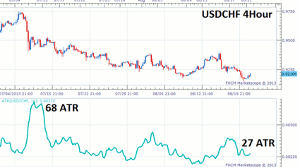Stop placement can be a difficult task in the creation of any forex strategy, and Walker England of DailyFX.com, reviews placing stops using the ATR volatility indicator.
Knowing how to manage risk on an open position is one of the most important steps in an active forex trading plan. To help make this process easier, there are a variety of indicators we can use to help determine where to place stop orders! Today we will focus on a method of measuring volatility while setting fixed stops using the ATR indicator.
What is ATR?
ATR (average true range) is an indicator that measures market volatility by comparing the difference of pips between previous highs and lows of a currency pair for a set number of periods. The greater the difference between these two points, regardless of market direction, the higher ATR will read. Depending on the totals, traders can then adjust their risk parameters.
The greater an ATR reading is on a specific pair, the greater the volatility currently is considered, and a wider the stop that should be used. This makes sense as a tight stop on a particularly volatile currency pair is more prone to be executed. As well, smaller stops can be used during times of less volatile pair. Taking this step can keep a trader from making stops unnecessarily large. Most traders using ATR will keep their initial stop at a minimum of 1X the ATR value away from their open price. Let’s look at an example.
USD/CHF 4-Hour with ATR

(Created using FXCM’s Marketscope 2.0 charts)
Click
to Enlarge
ATR and Risk
Above we can see the strong downtrend developing in the USD/CHF currency pair. Regardless of the strategy selected for trading this downtrend, traders will need to actively manage any new positions. Currently ATR on the USD/CHF 4-hour chart, resides at 27. This means that volatility has subsided by over half, relative to when this new trend began. Traders wishing to keep stops tighter in times of low volatility can use a 1ATR stop on new positions 27 pips away from their entry. With a stop value set at 27 pips, traders can then easily extrapolate a risk:reward ratio of their preference. Traders looking to take advantage of a 1 to 2 risk:reward ratio can multiply their risk in pips by two to achieve a final profit target of 54 pips on any new positions.
By Walker England, Trading Instructor, DailyFX.com
















